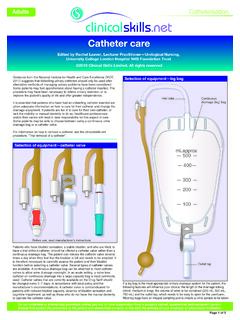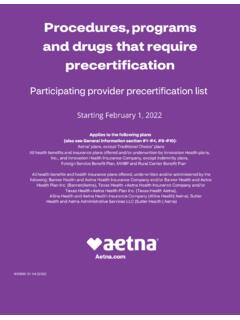Transcription of Recording a 12-lead electrocardiogram (ECG) - Clinical Skills
1 Adults Observations Recording a 12-lead electrocardiogram (ECG). Edited by Michael Sampson, Senior Lecturer, Cardiac nursing , London South Bank University, and Brian Campbell, Chair of Education, Society for Cardiological Science and Technology (SCST). 2019 Clinical Skills Limited. All rights reserved Recording a 12-lead electrocardiogram (ECG) is a common part of Clinical assessment in both secondary and primary care . In hospital, an ECG may be part Position of chest leads for Recording a 12-lead ECG. of pre-assessment for surgery or part of the admission procedure.
2 In an emergency, an ECG may be used to assess the electrical functioning of the heart and to detect damage to the myocardium. In primary care , an ECG may be performed as Midclavicular line Anterior axillary line Midaxillary line part of an overall health assessment, or to monitor ongoing Clinical conditions. An ECG, which is painless for the patient, involves placing electrodes on First specific parts of the chest and limbs, to record the heart's electrical activity. intercostal The subsequent tracing is recorded on graph paper and consists of 12.
3 Space specific waveforms, referred to as leads', each showing cardiac electrical activity from a different anatomical perspective. The data obtained allow an overall assessment of the rate and rhythm of the heart; the traces will also reflect any specific damage or changes to the structure of the heart. A 12-lead ECG can help to diagnose a variety of conditions, such as myocardial 1 2. infarction (the death of heart muscle due to a blocked coronary artery), 3. myocardial ischaemia (inadequate blood supply to the heart), enlargement of the ventricles, and a whole range of other abnormalities including cardiac 4 5 6.
4 Arrhythmias (abnormal and potentially dangerous heart rhythms). The 12-lead ECG is frequently used as part of a wider assessment, and is therefore a valuable tool in assessing the overall health status of the patient. This procedure is a guide to Recording a high-quality 12-lead ECG, a skill that requires regular practice. The guidance of an experienced practitioner or mentor is key. It is vital to position the electrodes correctly to ensure you obtain an accurate ECG Recording (Hammond & Spurgeon, 2015). The 12-lead ECG records 12 different electrical views of the heart, but only 10.
5 Electrodes are placed on the skin. There are two groups of electrodes: six chest The six precordial electrodes are placed across the chest wall (see above). electrodes (see right) and four limb electrodes. The four limb electrodes, placed Each electrode corresponds with a single ECG lead, unlike the limb on the wrists and ankles, provide the electrical information that produces the six electrodes. The precordial leads, also known as the chest leads, are V1, V2, limb leads on the ECG. They are called I, II, III, aVR, aVL and aVF.
6 V3, V4, V5 and V6. On some machines, they are labelled as C1 C6. The path of the electrical impulse through the heart (a) (b) (c) (d). Sinoatrial (SA) node AV Bundle node of His Atrioventricular Purkinje Right Left R R. (AV) node fibres bundle bundle P branch branch P T. Q S Q S. This illustration demonstrates how the movement of electrical activity through the heart creates normal ECG waveforms. Cardiac electrical activity is created by the depolarisation of cardiac cells. Depolarisation occurs when sodium ions rapidly enter the cell, causing a transient increase in the electrical charge across the cell membrane.
7 This electrical change spreads across the heart and triggers mechanical contraction of the upper and lower chambers in turn (Hampton, 2013). In the normal heart, depolarisation begins in the sinoatrial node, then spreads in a wavefront across both upper chambers until every cell has depolarised; this creates the P-wave on the ECG (a), and triggers atrial contraction. Depolarisation then reaches the atrioventricular (AV) node and passes slowly through it, which causes a small electrical delay, before it spreads rapidly through the bundle of His, bundle branches and Purkinje fibres.
8 While this is happening, a small flat line can be seen on the ECG (b). Once depolarisation reaches the Purkinje fibres, it spreads through the walls of the ventricles, creating the QRS complex of the ECG (c) and triggering ventricular contraction. Repolarisation of the ventricles, which is the return of the normal, resting electrical charge across the cell membrane, creates the final waveform on the ECG, the T-wave (d). Do not undertake or attempt any procedure unless you are, or have supervision from, a properly trained, experienced and competent person.
9 Always first explain the procedure to the patient and obtain their consent, in line with the policies of your employer or educational institution. Page 1 of 7. Adults Observations Recording a 12-lead electrocardiogram (ECG) Page 2. Assemble the equipment ECG Non-alcohol wipes machine 1 2. Q\ W@ 3. E# 4. R$ 5 6. T Y& U. 7. I. 8 9 0. O P Config mm/s Auto ! ? A S D. =. F_. - + *. G H~ J . %. K . ( 9. L X. Filter Man ; : Z X C. / , V . 6. B N 7. M . mm/mV Ergo Arrhy Alt Pat Tissues N. R. C1. R L. 1 2 C2. 3. 4 5 6. C3. 10 disposable pregelled electrodes Clipper C1.)
10 C2. N F. C3. L. F. Gather all the equipment you will need to record the 12-lead ECG. These items are usually kept together with the Recording machine for convenience and in case it is necessary to carry out a 12-lead ECG urgently. You may need to ask the patient to remove a watch or other jewellery; in this case, make sure they are stored safely. Explain the procedure and gain consent Position the patient Explain to the patient what you are going to do, and obtain consent. Even Pull the curtains or close the door to ensure privacy.









